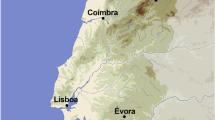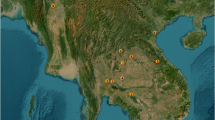Abstract
The recently excavated necropolises of Esfola (Beja) and Monte do Bolor 1/2 (Beja) display a characteristic architecture and distinctive funerary items that refer to the seventh to sixth century BC. The work comprises a microanalytical study of copper-based artefacts, some of them symbols of status, recovered in these necropolises (Tartesic belt buckles, body grooming instruments and different types of fibulae, bracelets and rings). The alloy composition was determined by micro-EDXRF and micro-PIXE analyses, while the colour distinction was estimated using the composition of different alloys. These funerary items disclose a metallurgy centred in low-tin bronze alloys (7.1 ± 2.4 wt% Sn, n = 41) with minor contents of lead, arsenic, nickel and iron. There are a few exceptions composed of copper or leaded bronze (c. 3.0 wt% Sn and 2.7 wt% Pb), in addition to arsenical copper (c. 5.6–6.5 wt% As), which is particularly remarkable due to the rarity of this last alloy in coeval contexts. A Tartesic belt buckle with rivets of distinct composition from the remaining components is other exception, as most composite artefacts have components of similar composition (e.g. pin, spring and axle of fibulae and body and decoration bead of bracelets and rings). Additionally, it was assessed that only a handful of examples were perceived as having a distinct colour and these outliers were mostly small body grooming instruments. Generally, the seventh to sixth century BC funerary items of southern Portugal disclose an indigenous metallurgy altered by earlier Phoenician stimuli, but the possibility to obtain different colours by changing the alloy composition was not commonly used.







Similar content being viewed by others
Data availability
All relevant data are within the manuscript.
References
Almagro Gorbea M, Lorrio AJ, Mederos A, Torres M (2008) La necrópolis de Medellín. II. Estudio de los Hallazgos. Real Academia de la Historia, Madrid
Arruda AM (2019) Phoenicians in Portugal. In: López-Ruiz C, Doak BR (eds) The Oxford handbook of the Phoenician and Punic Mediterranean. Oxford University Press, Oxford, pp 603–616
Arruda AM, Barbosa R, Gomes F, Sousa E (2016) A necrópole da Vinha das Caliças (Beja, Portugal). In Jiménez Ávila (ed) Sidereum Ana III. El río Guadiana y Tartessos. Consorcio Ciudad Monumental Histórico-Artística y Arqueológica de Mérida, Mérida, pp 187–225
Bottaini CE, Silva ALM, Covita DS, Moutinho LM, Veloso JFCA (2012) Energy dispersive X-ray fluorescence analysis of archeological metal artifacts from the Final Bronze Age. X-Ray Spectrom 41:144–149. https://doi.org/10.1002/xrs.2368
Bronk H, Rohrs S, Bjeoumikhov A, Langhoff N, Schmalz J, Wedell R, Gorny HE, Herold A, Waldschlager U (2001) ArtTAX - a new mobile spectrometer for energy-dispersive micro X-ray fluorescence spectrometry on art and archaeological objects. Fresenius J Anal Chem 371:307–316. https://doi.org/10.1007/s002160100989
Campbell JL, Boyd NI, Grassi N, Bonnick P, Maxwell JA (2010) The Guelph PIXE software package IV. Nucl Instrum Methods Phys Res B 268:3356–3363. https://doi.org/10.1016/j.nimb.2010.07.012
Cerdeño Serrano ML (1981) Los broches de cinturón tartésicos. Huelva Arqueol 5:31–56
Corregidor V, Alves LC, Rodrigues PA, Vilarigues M, da Silva RC (2011) The external ion beam facility in Portugal for studying cultural heritage. e-Conservation Magazine 22:1–14
Craddock PT (1995) Early metal mining and production. The University Press, Cambridge
Craddock PT, Meeks ND (1987) Iron in ancient copper. Archaeometry 29:187–204. https://doi.org/10.1111/j.1475-4754.1987.tb00411.x
Currie LA (1999) Nomenclature in evaluation of analytical methods including detection and quantification capabilities1 (IUPAC Recommendations 1995). Anal Chim Acta 391:105–126. https://doi.org/10.1016/S0003-2670(99)00104-X
Dias MMA, Coelho L (1983) Objectos arqueológicos de um túmulo de incineração da necrópole proto-histórica da Herdade da Favela Nova (Ourique). O Arqueólogo Português - 4ª Série 1:197–206
Fang J, McDonnell G (2011) The colour of copper alloys. Hist Metall 45:52–61
Farci C, Martinón-Torres M, González Álvarez D (2017) Bronze production in the Iron Age of the Iberian Peninsula: the case of El Castru, Vigaña (Asturias, NW Spain). J Archaeol Sci Rep 11:338–351. https://doi.org/10.1016/j.jasrep.2016.12.009
Figueiredo M, Mataloto R (2017) Necrópoles rurais sidéricas do Baixo Alentejo setentrional: sociedade e mundo funerário nos Barros de Beja. In Jiménez Ávila J (ed) Sidereum Ana III. El río Guadiana y Tartessos. Consorcio Ciudad Monumental Histórico-Artística y Arqueológica de Mérida, Mérida, pp 353–398
Figueiredo E, Silva RJC, Senna-Martinez JC, Araújo MF, Braz Fernandes FM, Inês Vaz JL (2010) Smelting and recycling evidences from the Late Bronze Age habitat site of Baiões (Viseu, Portugal). J Archaeol Sci 37(7):1623–1634. https://doi.org/10.1016/j.jas.2010.01.023
Giumlia-Mair AR (1992) The composition of copper-based small finds from a west Phoenician settlement site and from Nimrud compared with that of contemporary Mediterranean small finds. Archaeometry 34(1):107–119. https://doi.org/10.1111/j.1475-4754.1992.tb00480.x
Gomes FB (2015) The Olival do Senhor dos Mártires necropolis (Alcácer do Sal, Portugal) in the context of the Iron Age funerary practices of the Southwestern Iberian Peninsula. In: Rocha L, Bueno-Ramirez P, Branco G (eds) Death as archaeology of transition: Thoughts and materials. Archaeopress, Oxford, pp 327–341
Gutiérrez Neira PC, Zucchiatti A, Montero-Ruiz I, Vilaça R, Bottaini C, Gener M, Climent-Font A (2011) Late Bronze Age hoard studied by PIXE. Nucl Instrum Meth B 269:3082–3086. https://doi.org/10.1016/j.nimb.2011.04.072
Henderson J, Evans J, Nikita K (2010) Isotopic evidence for the primary production, provenance and trade of the Late Bronze Age glass in the Mediterranean. Mediterr Archaeol Archaeom 10(1):1–24
Huisman DJ, Bach A, Joosten I, Ngan-Tillard DJM, van den Eynde G (2020) Ceramic-faience hybrids were used to recycle bronze in North-Western European Iron Age egg-shaped crucibles. J Archaeol Sci Rep 32:10421. https://doi.org/10.1016/j.jasrep.2020.102421
Hunt-Ortiz MA (2003) Prehistoric mining and metallurgy in south west Iberian Peninsula. Archaeopress, Oxford
Ingo GM, De Caro T, Riccucci C et al (2006) Large scale investigation of chemical composition, structure and corrosion mechanism of bronze archeological artefacts from Mediterranean basin. Appl Phys A 83:513–520. https://doi.org/10.1007/s00339-006-3550-z
Ioannides D, Kassianidou V, Bonnerot O, Charalambous A (2016) A preliminary study of the metallurgical ceramics from Kition, Cyprus with the application of pXRF. J Archaeol Sci Rep 7:554–565. https://doi.org/10.1016/j.jasrep.2015.11.032
Jiménez Ávila J (2006) El conjunto Orientalizante de Talavera la Vieja (Cáceres). Junta de Extremadura, Cáceres
Jiménez Ávila J (2015) Phoenician bronzes in Spain. A western metalworking. In: Jiménez Ávila J (ed) Phoenician bronzes in Mediterranean. Real Academia de la Historia, Madrid, pp 395–442
López Castro JL (2019) The Iberian Peninsula. In: López-Ruiz C, Doak BR (eds) The Oxford Handbook of the Phoenician and Punic Mediterranean. Oxford University Press, Oxford, pp 585–602
Lyubomirova V, Djingova R, Kuleff I (2015) Comparison of analytical techniques for analysis of archaeological bronze. Archaeometry 57:677–686. https://doi.org/10.1111/arcm.12138
McLaren K (1976) XIII - The development of the CIE 1976 (L*a*b*) uniform colour-space and colour-difference formula. J Soc Dye Colour 92:338–341. https://doi.org/10.1111/j.1478-4408.1976.tb03301.x
Mecking O (2020) The colours of archaeological copper alloys in binary and ternary copper alloys with varying amounts of Pb. Sn and Zn J Archaeol Sci 121:105199. https://doi.org/10.1016/j.jas.2020.105199
Melo L, Silva AM, Soares RM, Dias G (in press) Os enterramentos da necrópole da 1ª Idade do Ferro do Esfola (Beja, Alentejo, Portugal). In Actas do X Encontro de Arqueologia do Sudoeste Peninsular (Zafra, 9–11 November 2018)
Mokrzycki WS, Tatol M (2011) Colour difference ΔE - a survey. Mach Graph Vis 20:383–411
Murillo-Barroso M, Martinón-Torres M, García Sanjuán L, Wheatley D, Hunt Ortiz MA, Forteza González M, Hernández Arnedo MJ (2015) J Archaeol Sci 57:322–334. https://doi.org/10.1016/j.jas.2015.03.013
Northover P (2004) Metallography of two experimentally cast bronze swords of Ewart Park type. In: Faolain SO (ed) Bronze artefact production in Late Bronze Age Ireland. Archaeopress, Oxford, pp 96–102
Oudbashi O, Hasanpour A (2018) Bronze alloy production during the Iron Age of Luristan: a multianalytical study on recently discovered bronze objects. Archaeol Anthropol Sci 10:1443–1458. https://doi.org/10.1007/s12520-017-0466-9
Oudbashi O, Hessari M (2017) Iron Age tin bronze metallurgy at Marlik, Northern Iran: an analytical investigation. Archaeol Anthropol Sci 9:233–249. https://doi.org/10.1007/s12520-015-0280-1
Ponte S (2006) Corpus signorum das fíbulas proto-históricas e romanas de Portugal. Caleidoscópio, Casal de Cambra
Radivojević M, Pendić J, Srejić A, Korać M, Davey C, Benzonelli A, Martinón-Torres M, Jovanović N, Kamberović Z (2018) Experimental design of the Cu-As-Sn ternary colour diagram. J Archaeol Sci 90:106–119. https://doi.org/10.1016/j.jas.2017.12.001
Renzi M, Montero-Ruiz I, Bode M (2009) Non-ferrous metallurgy from the Phoenician site of La Fonteta (Alicante, Spain): a study of provenance. J Archaeol Sci 36:2584–2596. https://doi.org/10.1016/j.jas.2009.07.016
Rovira S, Montero-Ruiz I (2013) Iberia: technological development of prehistoric metallurgy. In: Burmeister S, Hansen S, Kunst M, Müller-Scheeßel N (eds) Metal matters. Innovative technologies and social change in prehistory and antiquity. Verlag Marie Leidorf, Rahden, pp 231–239
Santos FJC, Antunes AS, Grilo C, Deus M (2009) A necrópole da I Idade do Ferro de Palhais (Beringel, Beja). Resultados preliminares de uma intervenção de emergência no Baixo-Alentejo. In: Pérez Macías JA, Bomba ER (eds) Actas del IV Encuentro de Arqueología del Suroeste Peninsular. Universidad de Huelva, Huelva, pp 746–804
Schiavon N, Celauro A, Manso M, Brunetti A, Susanna F (2013) Iron-Age bronze statuettes in southern Portugal: combining archaeological data with EDXRF and BSEM+EDS to assess provenance and production technology. Appl Phys A 113:865–875. https://doi.org/10.1007/s00339-013-7747-7
Soares R, Baptista L, Pinheiro R, Oliveira L, Rodrigues Z, Vale N (2017) A necrópole da I Idade do Ferro do Monte Bolor 1 -2 (S. Brissos, Beja). In Jiménez Ávila J (ed) Sidereum Ana III. El Río Guadiana y Tartessos. Consorcio de la Ciudad Monumental de Mérida, Mérida, pp 263–301
Valério P, Araújo MF, Soares AMM, Soares R, Baptista L (2017) O metal de base cobre dos objectos de uso pessoal em sepulturas da I Idade do Ferro do Monte Bolor 1–2 (Beja). In Arnaud JM, Martins A (eds) Arqueologia em Portugal. 2017 - Estado da Questão. Associação dos Arqueólogos Portugueses, Lisboa, pp 897–906
Valério P, Silva RJC, Araújo MF, Soares AMM, Barros L (2012) A multianalytical approach to study the Phoenician bronze technology in the Iberian Peninsula - a view from Quinta do Almaraz. Mater Charact 67:74–82. https://doi.org/10.1016/j.matchar.2012.02.020
Valério P, Silva RJC, Soares AMM, Araújo MF, Braz Fernandes FM, Silva AC, Berrocal-Rangel L (2010) Technological continuity in Early Iron Age bronze metallurgy at the South-Western Iberian Peninsula - a sight from Castro dos Ratinhos. J Archaeol Sci 37(8):1811–1819. https://doi.org/10.1016/j.jas.2010.01.038
Valério P, Silva RJC, Soares AMM, Araújo MF, Gonçalves AP, Soares RM (2015) Combining X-ray based methods to study the protohistoric bronze technology in Western Iberia. Nucl Instrum Meth B 358:117–123. https://doi.org/10.1016/j.nimb.2015.06.011
Valério P, Soares AMM, Araújo MF, Silva RJC, Santos FJC (2013) The distinctive grave goods from Palhais (Beja, Portugal). New insights into the metallurgical evolution under orientalizing influence in the southwestern end of Iberia. Trabajos Prehistoria 70(2):361–371. https://doi.org/10.3989/tp.2013.12119
Valério P, Soares AMM, Monteiro M, Pereira A, Araújo MF, Silva RJC (2016) Compositional and microstructural study of 8th century BC bronzes from Moita da Ladra (Tagus Estuary): how did the spread of the Phoenician metallurgy take place in Western Iberia? Archaeometry 58(4):593–609. https://doi.org/10.1111/arcm.12197
Acknowledgements
The authors acknowledge the use of the micro-EDXRF spectrometer from the Department of Conservation and Restoration from Faculdade de Ciências e Tecnologia of Universidade NOVA de Lisboa (DCR/FCT-NOVA).
Funding
The support of Fundação para a Ciência e a Tecnologia (FCT) to C2TN (UIDB/04349/2020) is gratefully acknowledged. Linda Melo acknowledge FCT PhD grant SFRH/BD/130165/2017 and Rui M. Soares acknowledge FCT PhD grant SFRH/BD/111511/2015.
Author information
Authors and Affiliations
Corresponding author
Ethics declarations
Conflicts of interest
The authors declare no competing interests.
Additional information
Publisher’s note
Springer Nature remains neutral with regard to jurisdictional claims in published maps and institutional affiliations.
Supplementary Information
Below is the link to the electronic supplementary material.
Rights and permissions
About this article
Cite this article
Valério, P., Araújo, M.F., Monge Soares, A.M. et al. Early Iron Age copper-based funerary items from southern Portugal. Archaeol Anthropol Sci 13, 114 (2021). https://doi.org/10.1007/s12520-021-01372-7
Received:
Accepted:
Published:
DOI: https://doi.org/10.1007/s12520-021-01372-7




